Saturday, November 26, 2005
Taj Mahal, Agra
The Taj Mahal in Agra. Vehicular traffic to the Taj has been stopped. You can only go on foot, or use a non-polluting vehicle. CNG (Compressed Natural Gas) vehicles are allowed. This would include buses and auto-rickshaws fitted with CNG kits. As you can see in this photo, these are mightily rickety contraptions that don't inspire much confidence.

Outside the Taj complex are arrays of shops that try to sell you everything from miniature Taj Mahal replicas, cold drinks, bangles, and almost everything else under the sun. They also make it a point to remind you that eatables and beverages are no longer allowed inside the Taj complex, so it's best to quench your thirst here.
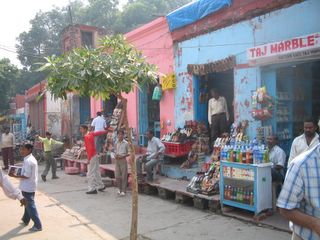
The ticket counter. The fees is about ten rupees per person for Indians, and Rs 750. Yes, you got that right. Wonder what happened to the 'atithi devo bhava' stuff. I suspect it's been replaced by 'sabse bada rupaiya'.

After you purchase a ticket you have to get past the security check, where they check and frisk and run a metal detector over you to make sure you are not carring any bombs or eatables. Yes, both are considered unacceptable inside the Taj.

This is the south gate to the Taj (or maybe it's the west gate, I am not sure).
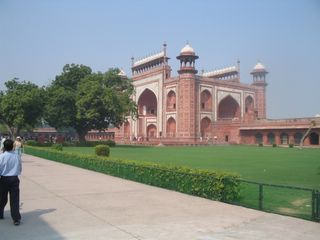
As you approach this gate, you start to get the first glimpse of the Taj. It's dome and a couple of minarets become visible.

As you walk through the gate, you get your first full view of the Taj. Impressive, to say the least.
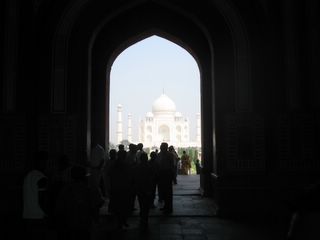
So this is how the Taj looks like from the entrance. At the left and right are mosques.

Ok, so if you get closer to the Taj, it still looks as white and beautiful and, uh, crowded. Even on a sweltering day with the mercury topping 35C there are hundreds and hundreds of people to be seen.

The compound is so huge, and the Taj so huge, that you can still get a shot that makes it appear that there aren't that many people around. Thank goodness for that.

There are huge gardens on either side of the central walkway to the Taj.
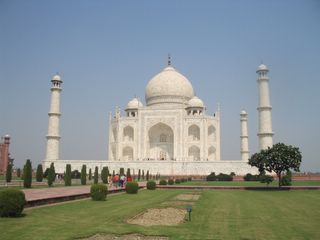
This is the view from the base of the Taj. If you climb up you get to the platform.

These are the stairs to the platform. One special thing to note about these stairs is that each step is made of a single marble stone. And the steps themselves are a good 10 inches high, sloping downwards slightly, which makes walking down a trickery process.

Once on the platform, if you look to the left, which I believe would be the north, you can see the Yamuna river flow. In the background, and a few kilometers away, is the Agra Fort.

The calligraphic inscriptions are from the Kuran, and is a fine example of inlay work. Which means that there is no painting here. The black text has been embedded within the marble. Run your fingers over the text and you can scarcely make out the transition from marble to text. What's also special about this text is that it increases in size the higher it goes, so that the entire text looks the same size when viewed from the bottom.
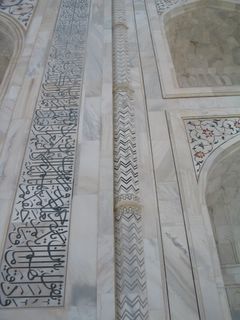
The Taj as viewed from the side of the Taj Mosque.

This is the Taj Mosque, built on the western side of the Taj Mahal. It is an exact replica of the strucure on the eastern side, called the Jama'at Khana (or Mehman Khana).

This is the Taj as seen from the Taj Mosque. In case you haven't figured it out, the Taj is symmetrically built, which means that it looks the same no matter from which side you view it. Try it sometime.

This is the plaque that describes the Taj Mosque and Jam'at Khana.

Finally, this is one of two plaques describing the Taj. The other plaque is in English.

This is the plaque in English.

Ok, so if you do not like to travel the short distance to the Taj in the rickety contraption I photographed, you have the option of getting a camel ride!

Lastly, this is another photo of the Taj from the Taj Mosque side.\

© 2005, Abhinav Agarwal (अभिनव अग्रवाल). All rights reserved. Reposted to this blog, July 2013.

Outside the Taj complex are arrays of shops that try to sell you everything from miniature Taj Mahal replicas, cold drinks, bangles, and almost everything else under the sun. They also make it a point to remind you that eatables and beverages are no longer allowed inside the Taj complex, so it's best to quench your thirst here.

The ticket counter. The fees is about ten rupees per person for Indians, and Rs 750. Yes, you got that right. Wonder what happened to the 'atithi devo bhava' stuff. I suspect it's been replaced by 'sabse bada rupaiya'.

After you purchase a ticket you have to get past the security check, where they check and frisk and run a metal detector over you to make sure you are not carring any bombs or eatables. Yes, both are considered unacceptable inside the Taj.

This is the south gate to the Taj (or maybe it's the west gate, I am not sure).

As you approach this gate, you start to get the first glimpse of the Taj. It's dome and a couple of minarets become visible.

As you walk through the gate, you get your first full view of the Taj. Impressive, to say the least.

So this is how the Taj looks like from the entrance. At the left and right are mosques.

Ok, so if you get closer to the Taj, it still looks as white and beautiful and, uh, crowded. Even on a sweltering day with the mercury topping 35C there are hundreds and hundreds of people to be seen.

The compound is so huge, and the Taj so huge, that you can still get a shot that makes it appear that there aren't that many people around. Thank goodness for that.

There are huge gardens on either side of the central walkway to the Taj.

This is the view from the base of the Taj. If you climb up you get to the platform.

These are the stairs to the platform. One special thing to note about these stairs is that each step is made of a single marble stone. And the steps themselves are a good 10 inches high, sloping downwards slightly, which makes walking down a trickery process.

Once on the platform, if you look to the left, which I believe would be the north, you can see the Yamuna river flow. In the background, and a few kilometers away, is the Agra Fort.

The calligraphic inscriptions are from the Kuran, and is a fine example of inlay work. Which means that there is no painting here. The black text has been embedded within the marble. Run your fingers over the text and you can scarcely make out the transition from marble to text. What's also special about this text is that it increases in size the higher it goes, so that the entire text looks the same size when viewed from the bottom.

The Taj as viewed from the side of the Taj Mosque.

This is the Taj Mosque, built on the western side of the Taj Mahal. It is an exact replica of the strucure on the eastern side, called the Jama'at Khana (or Mehman Khana).

This is the Taj as seen from the Taj Mosque. In case you haven't figured it out, the Taj is symmetrically built, which means that it looks the same no matter from which side you view it. Try it sometime.

This is the plaque that describes the Taj Mosque and Jam'at Khana.

Finally, this is one of two plaques describing the Taj. The other plaque is in English.

This is the plaque in English.

Ok, so if you do not like to travel the short distance to the Taj in the rickety contraption I photographed, you have the option of getting a camel ride!

Lastly, this is another photo of the Taj from the Taj Mosque side.\


Tuesday, November 22, 2005
Umrao Singh
The name will not ring a bell with most people. Umrao Singh was the last surviving Indian Victoria Cross winner. He died at the Army Research and Referral hospital in New Delhi on the 22nd of November 2005.
The Victoria Cross used to be the highest gallantry award awarded in pre-independence India, till it was replaced by the Param Vir Chakra after partition (Pakistan calls it the Nishan-i-Haider).
According to http://faculty.winthrop.edu/haynese/india/medals/VC/2USingh.html, Subedar Umrao Singh (and honorary Captain) was awarded the VC in recognition of his act of bravery on 15 December 1944 at Kaladan Valley, Arakan, Burma. The site also lists his date and place of birth as 21 November 1920, Palra village, Jhajjar, Rohtak tehsil, Haryana, and was the son of Mohar Singh Yadav.
The Hindu (link to page on The Hindu) carried a small obit with these comments:
Here is the list of links that carried the story (according to a Google News search I did at 1:45 pm):
© 2005, Abhinav Agarwal (अभिनव अग्रवाल). All rights reserved. Reposted to this blog 2013
The Victoria Cross used to be the highest gallantry award awarded in pre-independence India, till it was replaced by the Param Vir Chakra after partition (Pakistan calls it the Nishan-i-Haider).
According to http://faculty.winthrop.edu/haynese/india/medals/VC/2USingh.html, Subedar Umrao Singh (and honorary Captain) was awarded the VC in recognition of his act of bravery on 15 December 1944 at Kaladan Valley, Arakan, Burma. The site also lists his date and place of birth as 21 November 1920, Palra village, Jhajjar, Rohtak tehsil, Haryana, and was the son of Mohar Singh Yadav.
The Hindu (link to page on The Hindu) carried a small obit with these comments:
Subedar Major and Honorary Captain Singh (85), from Jhajjar in Rohtak, Haryana, won the Victoria Cross, the highest award for bravery under British India, for repulsing four Japanese attacks on his advanced battery position in the Kaladhan valley in Burma, on the night of December 15-16, 1944. He killed several Japanese soldiers before being grievously wounded. Six hours later, on a counter attack, Allied forces found him at the site of his gun, injured beyond recognition. Around him lay 10 dead Japanese soldiers. Subedar Major Singh was the last survivor among 40 Victoria Cross winners in the Indian Amy known for their feats in the First and Second World Wars."
Here is the list of links that carried the story (according to a Google News search I did at 1:45 pm):
- The Hindu (link)
- The Telegraph (Link)
- The Times (Link)
- Indian Express (Link)
- Outlook India (Link)
- Sify (Link)
- New Kerala (Link)
- Asian Age (Link)
- Govt of India's Press Information Bureau (Link)
- Daily News and Analysis (Link)
- The Statesman (Link)
- Chennai Online (Link)
- Mumbai Mirror (Link)
As a havildar on December 15/16 1944, Singh was in charge of one gun in the Kaladan Valley when it came under heavy fire from Japanese 74 mm guns. After an hour and a half of pounding, his section, consisting of two guns, was attacked by two Japanese companies. Under his inspired leadership it beat off the attack. Though twice wounded by grenades in the first attack, Singh held off the second by skilful control of the section's small arms' fire. At one point, with the attackers no more than five yards away, he manned a Bren gun himself and fired over the shield of his fieldpiece. Once again the Japanese were driven back, and the third and fourth attacks were beaten off, with the enemy suffering heavy casualties.And here is the bit from the Times:
When the final attack came, with his ammunition gone, the other gun over-run and all but two of his section badly wounded or dead, Singh closed with the enemy in furious hand-to-hand fighting. He struck down three Japanese in a desperate effort to save his gun, but was finally overwhelmed and knocked senseless.
Six hours later, when a counter-attack regained the position, Singh was found exhausted beside the gun, almost unrecognisable because of his seven wounds, with 10 dead Japanese lying around him. But the gun was still in working order.
The citation declared: "By his personal example and magnificent bravery Havildar Umrao Singh set a supreme example of gallantry and devotion to duty." Singh was invested with the Victoria Cross by King George VI at Buckingham Palace on October 15 1945.
AS A havildar (sergeant), Umrao Singh was the only non-commissioned officer of either the Royal Artillery or the Indian Artillery to be awarded the Victoria Cross in the Second World War. Forward observation officers are frequently at great personal risk when in exposed positions so as to direct artillery fire in support of armoured or infantry units. But Singh won his award for valour in what all gunners regard as their near-sacred duty — defence of the guns. By the end of 1944, General Sir William Slim’s 14th Army was poised for a right-flank offensive against Lieutenant-General Sakurai Seizo’s 28th Japanese Army in the coastal strip between the Irrawaddy and the Bay of Bengal. General Sir Philip Christison’s XV Corps of four divisions was given the job. The offensive was launched on December 12 but fierce resistance was met by the 81st
West African Division advancing down the Kaladan valley, every move forward being challenged by Japanese counter-attack. The 33 Mountain Battery, Indian Artillery, in which Havildar Umrao Singh was a field-gun detachment commander, was subjected to a sustained bombardment from Japanese 75mm guns and heavy mortars for one and a half hours on December 16, immediately before his gun position was attacked by two companies of Japanese infantry. Twice wounded by grenades during the first assault, Singh fought off the enemy with the detachment’s Bren light-machinegun while directing the rifle fire of the gun crew.
The second Japanese attack killed all the crew other than two members and himself, but was nevertheless beaten off. When the third assault came only a few rounds of small-arms ammunition remained and this was quickly used. With his last shot gone Singh seized a “gun bearer” — a heavy crowbar-like rod used for turning the gun trail — and closed with the attacking Japanese. He led the two surviving gun-crew members in hand-to-hand fighting until they were overwhelmed. He was seen to strike down three enemy infantrymen before falling under a rain of blows to the head.
Six hours later, after a counter-attack recovered the battery position, Singh was found unconscious beside his field-gun and almost unrecognisable from head wounds. Ten Japanese dead lay around him.
The citation for the award of the Victoria Cross read: “Havildar Umrao Singh set a supreme example of gallantry and devotion to duty.” His gun was still fit for firing and was in action again that day. He received his VC from King George VI at Buckingham Palace on October 15, 1945.
Monday, November 14, 2005
Apartments and Houses in Bangalore
House hunting is as much fun as repeated visits to the dentist. You try and make the best of things however. After a hopefully successful search, you can sit back and think of all the insights you may have gained. Whether or not that insight is applicable or practical is quite another matter.
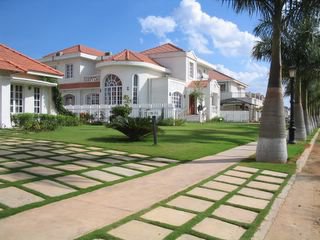 Adarsh Palm Meadows is one of the best I have seen so far. Well designed and laid out, the gated community is spread over 80 acres, and has some 550 villas and row houses, on plot areas ranging from a couple of thousand sq feet to 10,000 sq ft. Of course, it is also out of reach of most people, with prices upwards of a million dollars - five crores.
Adarsh Palm Meadows is one of the best I have seen so far. Well designed and laid out, the gated community is spread over 80 acres, and has some 550 villas and row houses, on plot areas ranging from a couple of thousand sq feet to 10,000 sq ft. Of course, it is also out of reach of most people, with prices upwards of a million dollars - five crores.
I am told that when this project, perhaps in 2000 or even earlier, villas could be had for sixty lakhs or so. Few however had imagined that the Whitefield area would see so much real-estate development, with residential, commercial, and office space coming up at such a frenetic, and unplanned, pace.
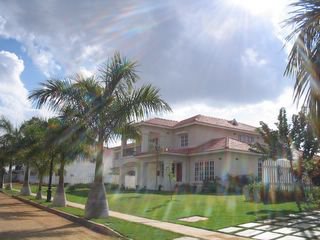
A model apartment at Mantri Rhythm. The original project never took off because of land acquisition problems. Mantri refunded the initial deposit money to the people in the end. They relaunched the project after waiting for some time, and at more than twice the rates.

With the explosion in housing in Bangalore, a lot of assembled kitchen and woodwork shops have sprung up. Ranging from the reasonably priced to the exorbitant ones.

Mantri Elite on Bannerghatta Road. Purva Heights is right opposite this, on the other side of the road. Mantri Elite was launched sometime in 2003, at rates starting at Rs 1600 per square foot.

Mantri Sarovar, opposite the Agara lake. The lake itself has been under renovation for a couple of years now. With the current govt's attitude towards development, the fate of the lake is very much hangs in the balance. As has been the case over the last 50 years or so, half the lakes in Bangalore have dried up as a result of encroachment. They have been allowed to dry up, and the land has then been encroached upon by builders who pay off politicians and bureaucrats.

Casa Ansal, on Bannerghatta Road, opposite Shopper's Stop. This is perhaps one of the first apartment complexes on Bannerghatta Road.

Prestige St John's Woods. The apartment complex itself is spacious with lots of open, green spaces. The surrounding environs is a mix of slums and junkyards. The going rate is believed to be in the vicinity of Rs 3500/sq ft. Which means a 2000 sq ft apt will cost you 70 lakh rupees, or more.

Brigade Millennium. The approach road, if you can call it that, is a drive through hell. The hope was that the road would be widened and made motorable. That was a few years back. Not happened yet, nor are there any hopes of that happening any time soon.

Purva Elita, a joint venture between Purva and Keppel of Singapore. Situated opposite Brigade Millenium, this project overlooks a lake (at least a bed of algae ridden water).
 © 2005, Abhinav Agarwal (अभिनव अग्रवाल). All rights reserved. Reposted to this blog, May 2013.
© 2005, Abhinav Agarwal (अभिनव अग्रवाल). All rights reserved. Reposted to this blog, May 2013.
 Adarsh Palm Meadows is one of the best I have seen so far. Well designed and laid out, the gated community is spread over 80 acres, and has some 550 villas and row houses, on plot areas ranging from a couple of thousand sq feet to 10,000 sq ft. Of course, it is also out of reach of most people, with prices upwards of a million dollars - five crores.
Adarsh Palm Meadows is one of the best I have seen so far. Well designed and laid out, the gated community is spread over 80 acres, and has some 550 villas and row houses, on plot areas ranging from a couple of thousand sq feet to 10,000 sq ft. Of course, it is also out of reach of most people, with prices upwards of a million dollars - five crores.I am told that when this project, perhaps in 2000 or even earlier, villas could be had for sixty lakhs or so. Few however had imagined that the Whitefield area would see so much real-estate development, with residential, commercial, and office space coming up at such a frenetic, and unplanned, pace.

A model apartment at Mantri Rhythm. The original project never took off because of land acquisition problems. Mantri refunded the initial deposit money to the people in the end. They relaunched the project after waiting for some time, and at more than twice the rates.

With the explosion in housing in Bangalore, a lot of assembled kitchen and woodwork shops have sprung up. Ranging from the reasonably priced to the exorbitant ones.

Mantri Elite on Bannerghatta Road. Purva Heights is right opposite this, on the other side of the road. Mantri Elite was launched sometime in 2003, at rates starting at Rs 1600 per square foot.

Mantri Sarovar, opposite the Agara lake. The lake itself has been under renovation for a couple of years now. With the current govt's attitude towards development, the fate of the lake is very much hangs in the balance. As has been the case over the last 50 years or so, half the lakes in Bangalore have dried up as a result of encroachment. They have been allowed to dry up, and the land has then been encroached upon by builders who pay off politicians and bureaucrats.

Casa Ansal, on Bannerghatta Road, opposite Shopper's Stop. This is perhaps one of the first apartment complexes on Bannerghatta Road.

Prestige St John's Woods. The apartment complex itself is spacious with lots of open, green spaces. The surrounding environs is a mix of slums and junkyards. The going rate is believed to be in the vicinity of Rs 3500/sq ft. Which means a 2000 sq ft apt will cost you 70 lakh rupees, or more.

Brigade Millennium. The approach road, if you can call it that, is a drive through hell. The hope was that the road would be widened and made motorable. That was a few years back. Not happened yet, nor are there any hopes of that happening any time soon.

Purva Elita, a joint venture between Purva and Keppel of Singapore. Situated opposite Brigade Millenium, this project overlooks a lake (at least a bed of algae ridden water).

KR Puram Bridge, Old Madras Road
The KR Puram bridge on the old Madras Road.
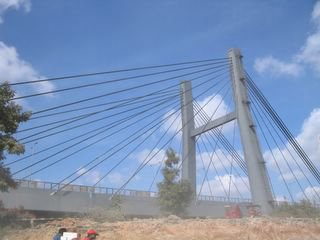
The bridge is not as wide or long as one may expect, but very picturesque indeed. It's been two years since I went that side, so no idea how it's weathered the two years since.

© 2005, Abhinav Agarwal (अभिनव अग्रवाल). All rights reserved. Posted to this blog, June 2013

The bridge is not as wide or long as one may expect, but very picturesque indeed. It's been two years since I went that side, so no idea how it's weathered the two years since.

Monday, November 7, 2005
Bangalore Malls
The Prestige Forum Mall is perhaps the most popular mall in Bangalore, and certainly seems to be the most profitable, given the amount of people that throng its aisles.
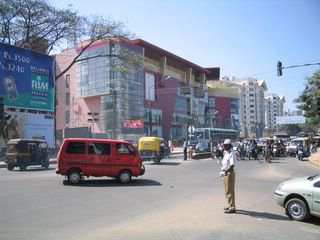
The mall opened in Feb 2004, and therefore the atrium looks so deserted - when I photographed it around that time.

I have never carried a tripod inside the mall, so I had to rest the camera on something that was a bit low, but I still liked the results. The reflections of the store on the floor is what makes this photo interesting to me.

With a tripod and a longer exposure this shot would look a lot better, but still, I will take this.

Given the total traffic chaos and mess on this stretch of road, it looks almost unbelievable that so little traffic can be seen...

This shot is again inside the Forum mall. The people here have thronged to the Coffee Day outlet that had a television set to watch the last few overs of the first one-day match between India and Pakistan in Pakistan. I believe this was -the- last over, and every dot ball drew deafeningly loud cheers and whistles. Yes, cricket in India still has the power to unite people like nothing else!
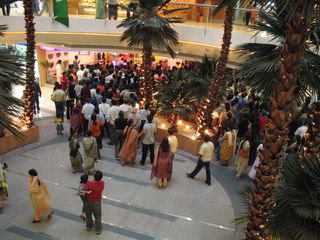
A wide (stitched) shot of the foodcourt in Forum mall.

The first day of the year 2005. The number of people was simply amazing.
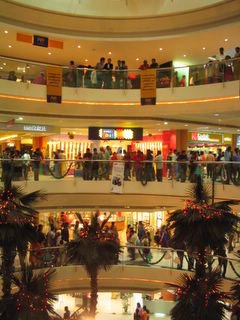
Garuda mall on Magrath Road is one of the latest additions to the rapidly growing list of malls in Bangalore. Relatively uncrowded, for the time being.

The foodcourt map at Garuda Mall.
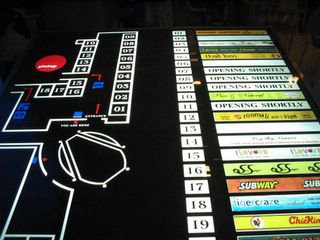
© 2005, Abhinav Agarwal (अभिनव अग्रवाल). All rights reserved. Reposted to this blog, May 2013

The mall opened in Feb 2004, and therefore the atrium looks so deserted - when I photographed it around that time.

I have never carried a tripod inside the mall, so I had to rest the camera on something that was a bit low, but I still liked the results. The reflections of the store on the floor is what makes this photo interesting to me.

With a tripod and a longer exposure this shot would look a lot better, but still, I will take this.

Given the total traffic chaos and mess on this stretch of road, it looks almost unbelievable that so little traffic can be seen...

This shot is again inside the Forum mall. The people here have thronged to the Coffee Day outlet that had a television set to watch the last few overs of the first one-day match between India and Pakistan in Pakistan. I believe this was -the- last over, and every dot ball drew deafeningly loud cheers and whistles. Yes, cricket in India still has the power to unite people like nothing else!

A wide (stitched) shot of the foodcourt in Forum mall.

The first day of the year 2005. The number of people was simply amazing.

Garuda mall on Magrath Road is one of the latest additions to the rapidly growing list of malls in Bangalore. Relatively uncrowded, for the time being.

The foodcourt map at Garuda Mall.

© 2005, Abhinav Agarwal (अभिनव अग्रवाल). All rights reserved. Reposted to this blog, May 2013
Friday, November 4, 2005
Sikandra, Agra
Sikandra, the tomb of Akbar. Akbar was the third Mughal emperor (Babur and Humayun being the first and second).
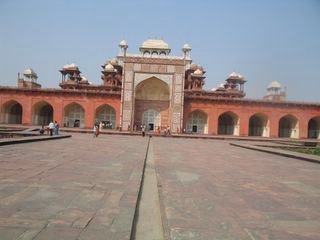
The tomb was built over seven years, from 1605-12.

The entrance to the compound. The tomb at Sikandra is said to occupy a larger area than the Taj. And the compound is huge indeed.
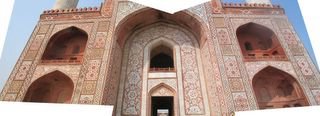
Note the differential admission fee for Indians and foreign nationals.

The imposing entrance to the compound.

This is the tomb of Akbar - to get here you have to walk down a narrow and damp passage. Quite austere.

The entrance to the cenotaph can be seen in this photo. Some of the inlay work can be seen here; some of the inlay work used to be in gold, don't know if it still exists there or not.

© 2005, Abhinav Agarwal (अभिनव अग्रवाल). All rights reserved. Reposted to this blog, July 2013.

The tomb was built over seven years, from 1605-12.

The entrance to the compound. The tomb at Sikandra is said to occupy a larger area than the Taj. And the compound is huge indeed.

Note the differential admission fee for Indians and foreign nationals.

The imposing entrance to the compound.

This is the tomb of Akbar - to get here you have to walk down a narrow and damp passage. Quite austere.

The entrance to the cenotaph can be seen in this photo. Some of the inlay work can be seen here; some of the inlay work used to be in gold, don't know if it still exists there or not.

© 2005, Abhinav Agarwal (अभिनव अग्रवाल). All rights reserved. Reposted to this blog, July 2013.
Subscribe to:
Posts (Atom)
